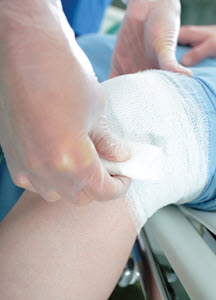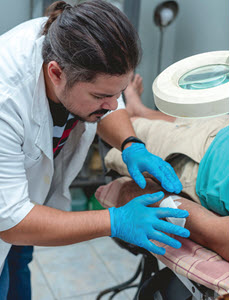ED: Wrap Up Wound Repair With This Expert Advice
Know the facts on components, complexity, and more. When patients present to the emergency department (ED) for wound repair, repairing the wound can be tricky — and so can coding the care. In fact, how many CPT® codes you submit for the claim will be up for debate. Why? Even in multiple-repair scenarios, there might only be an opportunity to report a single code. In fact, some wound repairs aren’t even codable as surgical procedures. To dodge any coding challenges when wound repair claims come across your desk, check out this expert advice on handling these claims. Recognize These 3 Factors Consider three factors when looking at a wound repair claim, said Corrie Alvarez, CPC, CPC-I, CEDC, CPMA, CEMC, CRC, CPCO, during a recent AAPC webinar: On the length of the wound, you should measure and record it in centimeters. Alvarez also reminded coders that 2.5 cm equals 1 inch. When you code for wound repair, “closure includes sutures, staples, or tissue adhesive,” said Alvarez. If the provider performs wound repair using only adhesive strips, report the fix with an ED evaluation and management (E/M) code from the 99281 (Emergency department visit for the evaluation and management of a patient that may not require the presence of a physician or other qualified health care professional) through 99285 (Emergency department visit for the evaluation and management of a patient, which requires a medically appropriate history and/ or examination and high level of medical decision making) code set. Use These 2 Components to Choose Correct Code Wounds are sorted by two major components: complexity and anatomic classification. There are three levels of wound repair complexity, says Brandy Harris, CPC, CPB: Simple: Repairs are simple when there is closure with a “single-layer suture, which involves only the epidermis, dermis or subcutaneous tissue — no debridement, no deep sutures, no heavy cleaning of wound,” she says. Intermediate: Repairs are intermediate when there is closure with a multi-layer suture, which involves closure of one or more deeper layers of subcutaneous tissue in addition to the skin (epidermal and dermal) closure — “or is a single-layer suture but the wound is contaminated and needs heavier cleaning,” according to Harris. Complex: The ED is less likely to perform complex wound repairs, but there are instances where it might be necessary. “This is for traumatic open wounds. Layers involve all layers of skin continuing down to the muscle, and/or tendons, cartilage, bone,” explains Harris. Complex repair can include scar revision, debridement, undermining of tissue, and/or retention sutures. Know How CPT® Breaks Codes by Anatomy You’ll report your wound repairs using codes from the 12001 (Simple repair of superficial wounds of scalp, neck, axillae, external genitalia, trunk and/or extremities (including hands and feet); 2.5 cm or less) through +13153 (Repair, complex, eyelids, nose, ears and/or lips; each additional 5 cm or less (List separately in addition to code for primary procedure)) code set. The anatomy that each code represents differs depending on the complexity of the repair: Simple repairs: CPT® groups simple wound repairs in the following anatomic categories: Intermediate repairs: CPT® groups intermediate wound repairs in the following anatomic categories: Complex repairs: CPT® groups complex wound repairs in the following anatomic categories: When coding for wound repairs, you’ll code repairs of different complexity or in different anatomical areas with different codes. For example, if the notes indicate that the provider performed an intermediate repair on a patient’s neck and a simple repair on a patient’s face, you’d report two separate codes. On multiple repairs, don’t forget to append modifier 59 (Distinct procedural service) to all repair codes other than the primary code. If the repairs are in the same anatomical area and are of the same complexity, however, you’ll add up the repair lengths and choose a code based on that number. For example, if the provider performs two intermediate wound repairs on a patient’s leg, you’d add the repair lengths up and choose a single CPT® code. Report Debridement When Necessary The following services are included in wound repair codes, Alvarez says: If, however, the physician needs to perform extensive debridement, you could report the following codes independent of the wound repair code (Codes have been resequenced, which is why CPT® lists the codes in this order):


